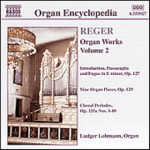
Organ Works, Vol. 2-Introduction, Passacaglia and Fugue in E minor / 9 Organ Pieces / Choral Preludes
 $25.00
Out of Stock
$25.00
Out of Stock2-4 weeks add to cart
MAX REGER
Organ Works, Vol. 2-Introduction, Passacaglia and Fugue in E minor / 9 Organ Pieces / Choral Preludes
Ludger Lohmann (organ)
[ Naxos Organ Encyclopedia / CD ]
Release Date: Sunday 1 June 2008
This item is currently out of stock. We expect to be able to supply it to you within 2 - 4 weeks from when you place your order.
Johann Baptist Joseph Maximilian Reger was born in Bavaria in 1873 and died in Leipzig, at the age of 43, in 1916. Although he has been described recently as a musical descendant of Brahms, in his own time, he was often criticized as a subversive revolutionary.
In his rôles as teacher, performer, conductor and composer, Reger always achieved great professional success, and, as a composer of organ music, he is considered the most important German composer since Bach.
The monumental Introduction, Passacaglia und Fugue in E minor, Op. 127, was written during April and May, 1913 to fulfill a request from the city of Breslau. Originally the capital of Silesia in the twelfth century, Breslau was under Habsburg, and then Prussian rule, until passing to Poland in the aftermath of World War II. It is now known as Wroclaw. The year 1913 saw the completion of Breslau's Jahrhunderthalle, built to commemorate the centennial of the anti-Napoleonic revolt. The organ, built for this hall by the firm of Wilhelm Sauer of Frankfurt/Oder, was one of the largest instruments in the world with 15,000 pipes and 200 stops, spread over five manuals. Reger's commission specified a large work for organ and orchestra, much like the Festliches Praeludium, Op. 61, by his friend Richard Strauss (also written in 1913 for the inauguration of the enormous Rieger organ in the Vienna Konzerthaus). Reger's involvement with other orchestral projects at this time, however, most notably, the Böcklin Suite, Op. 128, and the Ballet-Suite, Op. 130, may have dictated the simplification of these requirements, and the resulting work for organ alone. There was an interval of eight years between Op. 127, in 1913, and his last major organ work, the Second Suite in G Minor, Op. 92, in 1905. As with many of Reger's previous organ pieces, Op. 127 was written for, and dedicated to, Karl Straube (1873-1950). Like Reger, Straube had been a pupil of Hugo Riemann in Wiesbaden. From the moment of his first meeting with Reger in 1898, Straube became a staunch advocate of the composer's music, his musical advisor, and his closest friend. Straube served as organist at the Willibrordi-Kirche in Wesel from 1897 to 1903, and then took the prestigious position of organist, and later Kantor of the Thomaskirche in Leipzig. He also became an organ teacher at the Leipzig Conservatory in 1907. Reger considered Karl Straube to be the greatest organist in Germany and by far the best interpreter of his organ works. Several impressive concerts were planned for the opening celebrations of the Breslau hall, including an all-Bach organ recital by Straube, and a full-scale performance of the massive Symphony No. 8 ("Symphony of a Thousand") by Gustav Mahler. On 24th September, 1913, Straube gave a recital, which featured the first performance of Reger's Op. 127, as part of a programme which included works by Byrd, Banchieri, Zipoli, Liszt, Buxtehude, Pachelbel and Franck Critical reaction to the première was mixed. While certain critics found the work strange and highly dissonant, others were impressed by Reger's mature style, with his effortless command of strict counterpoint, and his "wild" exploratory harmonies. Everyone complained about the work's excessive length. (If contemporary accounts are correct, Straube's performance required forty minutes!)
Tracks:
Introduction, Passacaglia and Fugue in E minor, Op. 127
9 Organ Pieces, Op. 129
Choral Preludes, Op. 135a, Nos. 1-10


